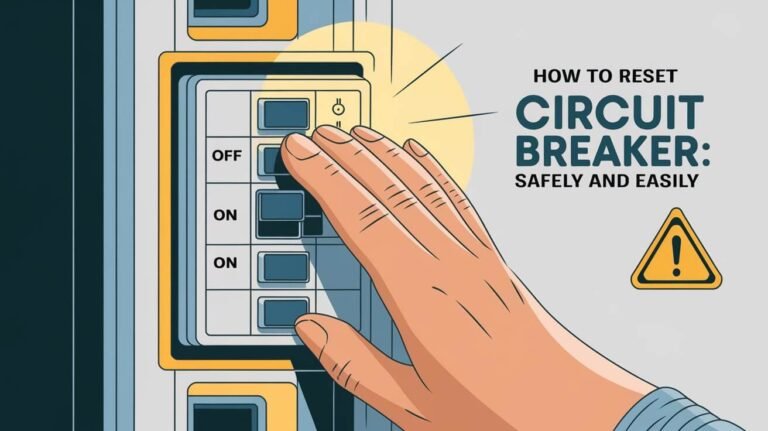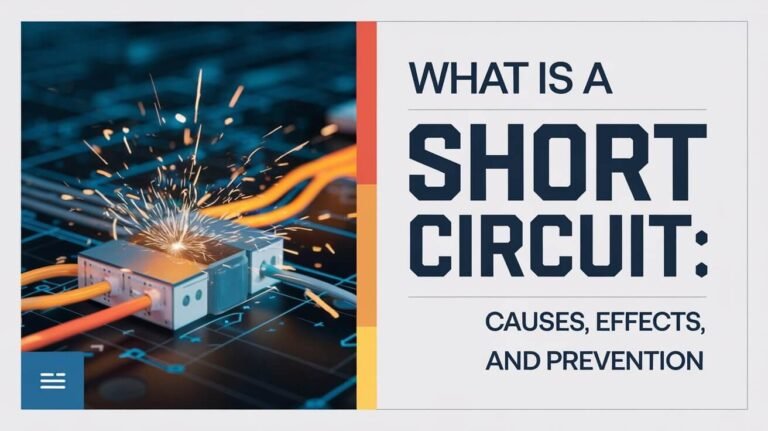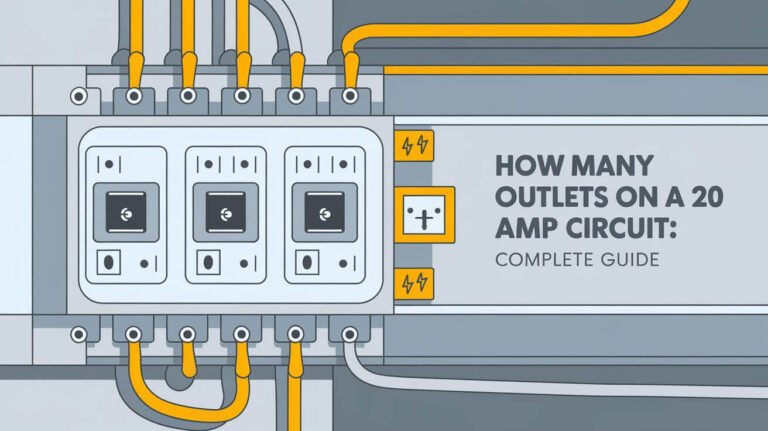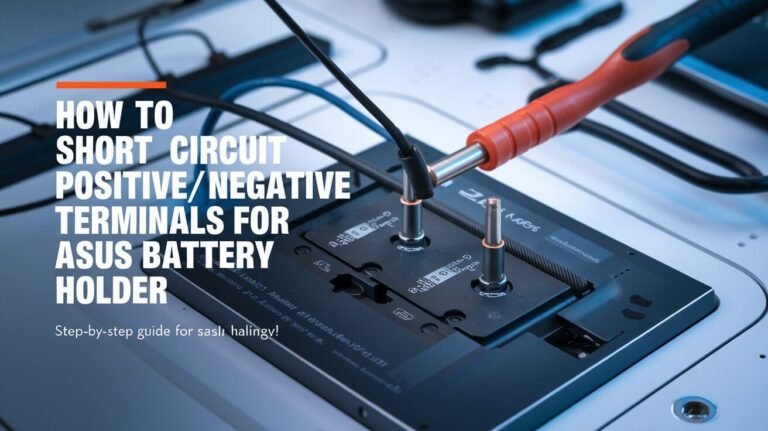
In the world of electrical circuits, a series circuit is a basic setup. Components are connected one after another, creating a single path for electric current. This design is simple and ensures current flows in a consistent way.
It’s perfect for simple electronic projects and teaching. Knowing the parts and how they work in a series circuit helps us grasp its fundamental principles.
Circuit Fundamentals: Core Components and Their Functions
Understanding series circuits starts with knowing the basic parts. At the center is a power source, like a battery or voltage source. It gives the circuit the voltage it needs to work.
Power Sources and Their Role
The power source is key in a series circuit. It gives the voltage needed for the circuit to function. This can be a battery, a wall outlet, or a special voltage source.
Essential Circuit Elements
Series circuits also have important parts like resistors, capacitors, and inductors. These elements shape how the circuit works. They affect the current flow, voltage, and overall performance.
Current Flow Mechanics
In a series circuit, current flows through one path. Each part is connected in a loop. The current stays the same from start to finish. Knowing this is key to designing series circuits.
| Component | Function |
|---|---|
| Resistor | Regulates the flow of current and creates voltage drops within the circuit. |
| Capacitor | Stores and releases electrical charge, influencing voltage and current behavior. |
| Inductor | Creates a magnetic field that opposes changes in current, affecting voltage and current dynamics. |
Characteristics of Series Circuit Connections
Series circuit connections have unique properties that make them different from other circuits. These traits are key to understanding how series circuits work and their uses.
The current in a series circuit stays the same everywhere. This means each part gets the same amount of current, no matter its resistance. This constant current is a main feature of series circuits and affects how we design and analyze them.
Series circuits also have a special way of adding up resistances. The total resistance is just the sum of each part’s resistance. This makes it easy to figure out the circuit’s overall resistance and how it affects the circuit’s performance.
Voltage in series circuits is divided among the parts. Each part gets a share of the voltage, with the amount depending on its resistance. This is important for understanding how series circuits work and how to make them better.
Series circuits are also very sensitive to failures. If one part fails, the whole circuit stops working. This can be both good and bad, depending on the situation. Series circuits are simple and predictable, but they need careful planning to avoid failures.
Knowing these key features of series circuit connections helps us design and use them better. They are crucial in many areas, from holiday lights to industrial controls. The properties of series circuits ensure these systems work well and reliably.
What Is A Series Circuit
A series circuit is a basic electrical setup where parts are linked one after another. This creates a single path for current to flow. The same current goes through each part in order. The power source’s voltage is split among the parts, causing each to have its own voltage drop.
Basic Series Circuit Structure
The main traits of a series circuit are:
- Single, continuous path for current flow
- Components connected one after the other
- Same current passing through each component
- Voltage divided across the components
Current Path Analysis
In a series circuit, the current stays the same everywhere. This is because there’s only one path for the current to follow. The same amount of charge must go through each part. So, the current is the same at every point in the circuit, ensuring a steady flow.
Voltage Distribution Principles
The total voltage from the power source is split among the parts in a series circuit. Each part has a voltage drop, and these drops add up to the circuit’s total voltage. The drop across each part depends on its resistance. Parts with higher resistance have a bigger drop.
| Series Circuit Examples | Current Path in Series Circuits | Voltage Drop Calculation |
|---|---|---|
| Old-style Christmas lights, where a single broken bulb interrupts the entire circuit | The same current flows through each component in a series circuit | The voltage drop across each component is proportional to its resistance, with the sum of the individual voltage drops equaling the total voltage of the circuit |
Series vs Parallel Circuits: Key Differences
Electrical circuits come in two main types: series and parallel. Knowing the differences between them is key for designing and fixing electrical systems.
In a series circuit, components are connected one after another. This means the same current flows through each part. In contrast, parallel circuits have components connected to a common voltage source. Each part has its own path for current, allowing it to be split among branches.
| Characteristic | Series Circuit | Parallel Circuit |
|---|---|---|
| Current Flow | The same current flows through all components. | The current is divided among the branches. |
| Voltage Distribution | The voltage is divided among the components. | The voltage is the same across all components. |
| Resistance Calculation | The total resistance is the sum of the individual resistances. | The total resistance is calculated using the reciprocal of the individual resistances. |
| Component Failure | A single component failure can cause the entire circuit to stop functioning. | A single component failure only affects the branch it is in, while the rest of the circuit can continue to function. |
Series circuits are often used in simple electronics needing a single current path. Parallel circuits, by contrast, are common in home wiring. They allow multiple devices to run at once from a single voltage source.
It’s vital for engineers, technicians, and hobbyists to understand series and parallel circuits. This knowledge helps them design and fix electrical systems better. It ensures these systems work well and reliably.
Calculating Total Resistance in Series Circuits
Series circuit calculations are simple. The total resistance is just the sum of all resistances. This rule is key for understanding how a circuit works, including how current flows and voltage is spread out.
Resistance Addition Method
To find the total resistance in a series circuit, add each resistance together. The formula is:
R_total = R1 + R2 + R3 + … + Rn
This method makes it easy to find the total resistance. It’s a basic step for analyzing series circuits.
Practical Resistance Calculations
Let’s look at an example. Imagine a circuit with resistors of 2 Ω, 5 Ω, and 7 Ω. The total resistance is:
R_total = 2 Ω + 5 Ω + 7 Ω = 14 Ω
Knowing how to add resistances helps us find the total resistance in any series circuit. It doesn’t matter how many resistors there are.
Impact on Circuit Performance
The total resistance in a series circuit affects how well it works. As total resistance goes up, current goes down. This is because of Ohm’s Law (V = IR). Lower current means less power used and different voltages across components.
Understanding series circuit calculations is vital for those working in electronics and electrical engineering. By managing total resistance and current, they can make sure series circuits work well and efficiently.
Voltage Distribution Across Series Components
In a series circuit, voltage is split among components based on their resistance. This is key to understanding how voltage drops and distributes. It helps us see the potential difference in each part.
Ohm’s Law, V = IR, shows how to find voltage drops. Here, V is the drop, I is the current, and R is the component’s resistance. The total voltage from the source is the sum of these drops.
Let’s say we have a circuit with three resistors (R1, R2, and R3). The voltage drops across each would be:
- Voltage drop across R1:
V1 = IR1 - Voltage drop across R2:
V2 = IR2 - Voltage drop across R3:
V3 = IR3
The total voltage, Vtotal, is the sum of these drops:Vtotal = V1 + V2 + V3
This rule is vital for designing circuits. It ensures each component gets the right voltage to work properly.
| Component | Resistance (Ω) | Current (A) | Voltage Drop (V) |
|---|---|---|---|
| R1 | 10 | 0.5 | 5 |
| R2 | 20 | 0.5 | 10 |
| R3 | 30 | 0.5 | 15 |
| Total | 60 | 0.5 | 30 |
The table shows how voltage is split among three resistors. The total drop is the sum of each drop.
Current Flow Properties in Series Arrangements
Series circuits have interesting properties when it comes to current flow. These properties make circuit analysis and measurement easier. We will look at the main rules that govern current in series circuits. We will also explore how to accurately measure this important parameter.
Current Consistency Rules
In a series circuit, the current stays the same throughout. This is true no matter the values of the components. Each component gets the same current. This is because of Kirchhoff’s Current Law.
This law says that the sum of currents entering a node must equal the sum of currents leaving. Since there’s only one path in a series circuit, the current stays constant. This makes circuit analysis simpler.
Measuring current in a series circuit is easy. Just connect an ammeter in series with the component you want to measure. The ammeter reading will show the total current in the circuit. This is because the current is the same everywhere.
| Parameter | Value |
|---|---|
| Equivalent Resistance (R_S) | 90 Ω |
| Voltage (V) | 9 V |
| Current (I) | 0.1 A |
| Total Power Dissipated | 0.9 W |
In the example, the current in the series circuit was 0.1 A. This was with a 9 V voltage source and an equivalent resistance of 90 Ω. This shows how easy it is to measure current in series circuits, where the same current flows through all components.
Real-World Applications of Series Circuits
Series circuits are used in many ways in our daily lives. They are found in voltage dividers, which split the voltage for different parts of a circuit. For example, old Christmas lights would turn off if one bulb failed.
Car systems also use series circuits. Batteries are connected in series to get more voltage. This is important for powering car parts. Series circuits are also in simple devices, voltage regulators, and some lights, because they work well and are easy to understand.
Series circuits are key in safety devices like circuit breakers and fuses. They are connected to outlets to cut off power when needed. This prevents dangers. Their simplicity and reliability make them essential in many fields and products.






